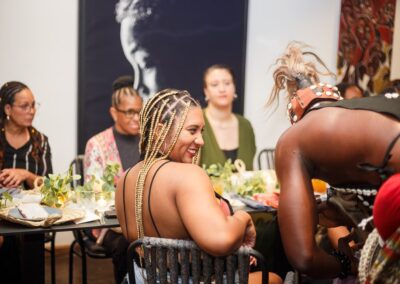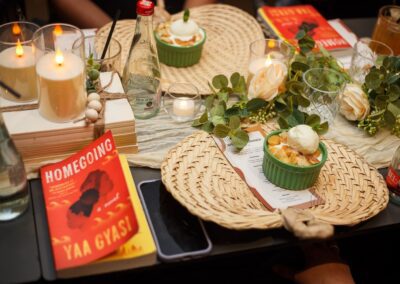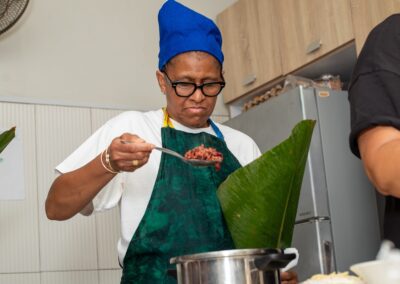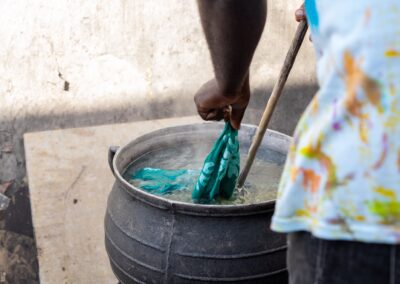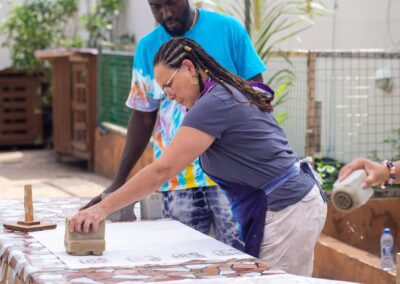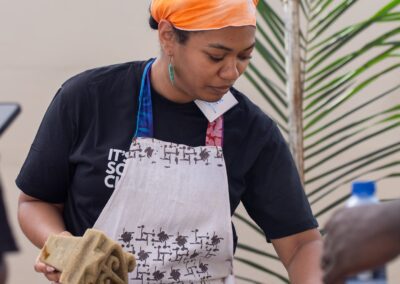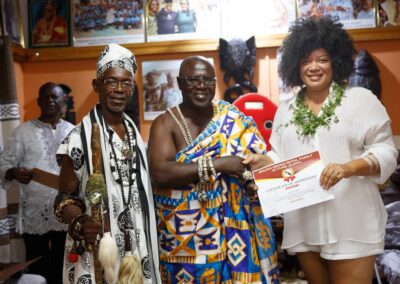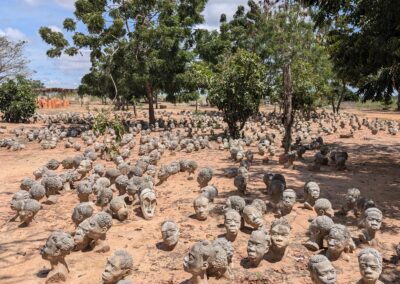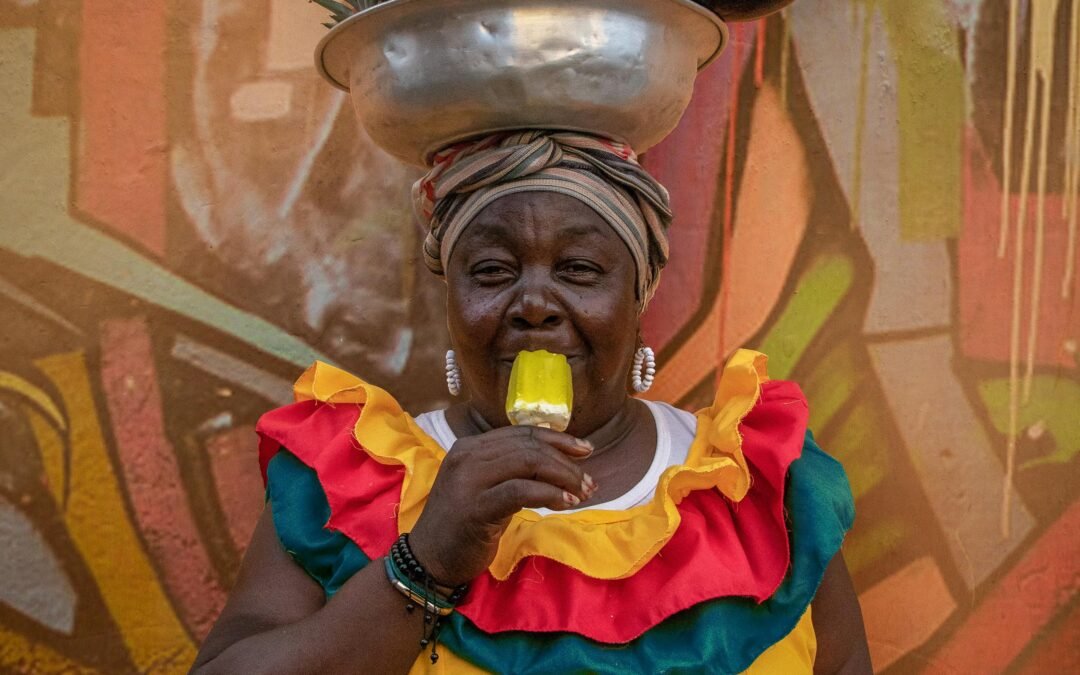A “Homegoing” Journey: Our Accra Adventure

We recently wrapped up an incredible trip to Accra, Ghana, inspired by Yaa Gyasi’s Homegoing. Our group of amazing women, ranging from 29 to 61, had the opportunity to explore this vibrant city and delve into its rich history.
Accra is a fascinating blend of old and new. As the former Gold Coast, its history is deeply rooted in the gold trade. It was also the first sub-Saharan African nation to gain independence, playing a crucial role in Pan-Africanism. Homegoing was the perfect guide for our journey. The book follows two half-sisters, Effia and Esi, through centuries of slavery, colonialism, and resilience. It’s a powerful exploration of power, privilege, and the enduring impact of the slave trade.
Our trip aimed to bring the pages of Homegoing to life. We visited historical sites, met local artists, and learned about the ongoing effects of the slave trade. We also experienced the vibrant Ghanaian culture, from its delicious food to its lively music. It was a transformative experience for all of us. We not only learned about Ghana’s history but also unearthed our own stories while being welcomed home.
Day 1: Opening Dinner & Book Discussion
“When you study history, you must always ask yourself, whose story am I missing? Whose voice was suppressed so that this voice could come forth?” – Homegoing by Yaa Gyasi, pg. 226
Each of our experiences starts with an opening dinner and book discussion where we welcome our travelers to the country, create connections over a meal, and get the chance to have an in-depth discussion of the book.
During introductions we share our names, the places that feel like home, and a sharing of who our people are. Who are the people that make us feel seen, valued, and most like our best selves. Each trip it is a delight to find that we are each other’s people.
Food is a great equalizer. It creates connection, joy, and a sense of history and culture when you’re new to a place. It is our welcome to our communal table and a reminder that we are all bound here together to experience something special.
Catch highlights from our opening dinner and book discussion below.
Day 2: Essential Accra – Makola Market, Accra Arts Center, Gallery 1957, Black Star Square and the Kwame Nkrumah Memorial.
We started the day at Makola Market, once the largest open-air market in West Africa. Our travelers got a quick lesson and support on haggling as they purchased jewelry and fabric as many women got clothes made on the trip by our hand selected tailor. After shopping we had a delicious lunch of local dishes including red red, jollof rice, ground nut soup, tilapia, palm wine and more at Accra Arts Center.
“No one forgets that they were once captive, even if they are free. But still, Yaw, you have to let yourself be free.” – Homegoing by Yaa Gyasi, pg. 242
During our opening dinner we discussed the heavy nature of “Homegoing” and how few stories of Black joy get told, so it was important to us to highlight the joy that can live beside that hard history. After lunch we had a fun and interactive drumming and dancing lessons that the ladies loved.
“They had given all they had, assured that it would come back to them in the abundance of freedom.” – pg. 191, Homegoing by Yaa Gyasi
As we explored Accra, we couldn’t miss a visit to the Kwame Nkrumah Memorial Park and Mausoleum. This iconic site honors Ghana’s first president and a true champion of Pan-Africanism.
In the period of African colonial independence the beacon country from Africa was Ghana, first to achieve independence in 1957. Kwame Nkrumah was a visionary leader who played a pivotal role in Ghana’s independence and served as the country’s first African-born Prime Minister of Ghana and President. He was a prolific writer that published many liberation focused texts.His bold leadership and radical ideas inspired other African countries to fight for their freedom. By the mid-1960s, over 30 African nations had achieved independence, thanks in part to Nkrumah’s example.
Standing beneath the Independence Arch at Black Star Square, we couldn’t help but feel a sense of awe and inspiration. This vibrant hub is a symbol of Ghana’s independence and a reminder of the country’s rich history.
Day 3: Batik-Making & Ghanaian Cooking Class

Our third day in Accra was a whirlwind of cultural immersion. We were fortunate enough to spend the day with Auntie Awo, a local entrepreneur and cultural bearer, who invited us into her home for a truly unforgettable experience.
We started our day with a grounding in Ghanaian history and culture which tied perfectly with the historical fiction laid out in “Homegoing.” . Auntie Awo explained the significance of Ghanaian day names, which are given based on the day of the week you were born. We also learned about historical figures like Yaa Asantewaa, the Queen Mother of the Asante kingdom, who led a fierce resistance against British colonial rule. The Asante where one of the few African states that seriously resisted European colonization. Between 1823 and 1896, the United Kingdom of Great Britain fought four wars against the Asante during the Anglo-Asante Wars. In 1935 the British finally granted the Asante self-rule sovereignty as the Kingdom of Asante.
One of the most fascinating aspects of our visit was learning about Adinkra symbols. These pictorial representations originated in Ghana and are used to convey philosophical and spiritual meanings. We later used these symbols to adorn our batik fabrics.
After our history lesson, we were treated to a delicious spread of Ghanaian cuisine. We enjoyed jollof rice, fried chicken, tilapia, coconut rice with agushie stew, kelewele, tatale with beans stew, kontomire stew with cocoyam, and waakye. We couldn’t get enough!
We each created our own unique batik fabric, capturing the essence of our Ghanaian experience. Batik originates from the island of Java in Indonesia and the style was brought to Ghana by Dutch merchants in the mid 19th century. It is a detailed process where hot wax is applied to fabric to resist dye, resulting in unique patterns telling stories of culture, community and heritage. Our time with Auntie Awo and her sons was a highlight of our trip. We left her home feeling inspired, enriched, and deeply connected to Ghanaian culture.
Day 4: Naming, Healing, and Renewal- Elmina Castle and Ghanaian Naming Ceremony
“In my dreams I kept seeing this Castle, but I did not know why. One day, I came to these waters and I could feel the spirits of our ancestors calling to me. Some were free, and they spoke to me from the sand, but some others were trapped deep, deep, deep in the water so that I had to wade out to hear their voices… I put you in here so that if your spirit ever wandered, you would know where home was.” – Homegoing by Yaa Gyasi, pg. 268
Leaving Accra, we embarked on a four-hour journey to Cape Coast, the setting for the opening scenes of Homegoing. Our first stop was Kakum National Park, a lush rainforest with a stunning 7-bridge canopy walkway to ground in nature before an emotional day.
After the park we went to Elmina Castle, more appropriately named slave dungeons, where the Portuguese, Dutch and then the British captured and sold enslaved West Africans. Built by Portuguese traders in 1482, Elmina slave dungeons were the first European slave-trading post in all of sub-Saharan Africa. Located on the western coast of present day Ghana, it came to serve the Dutch slave trade with Brazil and the Caribbean. It later came under British ownership in the 1800s the timeline is which Homegoing opens.
Our guide, Kojo, a local historian, led us through the harrowing history of the slave trade. He started by grounding us in the importance of naming. Both naming this place slave dungeons instead of slave castles and understanding the original name of Elmina – Anomansa. We walked through the Door of No Return, imagining the countless lives that passed through this infamous gateway.
After this emotional experience, we went to Coconut Grove resort for a 30-minute meditation session led by Jamilah a Black expat who has made Cape Coast her home. She incorporated movement, sound healing, and breath work to help us process our emotions after visiting the slave dungeons.
Later that evening we had the great honor of being invited to a traditional naming ceremony with the King of the Iture community. During our greeting we were told “your coming here this evening is not new to us. It is a prophecy that our ancestors have said and it has come to fruition.”
During the ceremony each person was given their Ghanaian names and personally welcomed in as new members of the Eku-Na Nsona royal family. Our Ghanaian names included our day names as well as special second names given to use by the village elders based on characteristics the ancestor foretold for us. Symbolizing the necessity of speaking up and naming good and evil we were given a cup of water and then a cup of alcohol and told to sip from both three times calling out what we were tasting. This portion of the ceremony centered the importance of living a values-driven life.
To end the ceremony each person received a garland with Nyenya, a healing herb that provides spirtual protections, fights diabetes, and promotes good digestation. Mud from the area where our ancestors last saw the shore of Ghana was placed on arms in three stripes while the gathering called out “victory” to symbolize our return. As we danced and connected with the local community, we felt a deep sense of belonging. This was one of the most memorable experiences of our trip. One traveler said this experience “took the trip to unexpected spiritual heights.”
Day 5: Free Day to Explore Accra
Our travelers had a much needed free day to explore Accra. We scheduled an optional shuttle to some of the best boutiques and markets in Accra for those who wanted to shop, some travelers got massages, and others relaxed at the hotel pool.
Day 6: Healing and Honoring Through Art
“What he wanted to capture with his project was a feeling of time, of having been a part of something that stretched so far back, was so impossibly large, that it was easy to forget that she, and he, and everyone else, existed in it- not apart from him, but inside of it.” – Homegoing by Yaa Gyasi, pg. 296

During our last full day of the trip we visited the Nkyinkyim Museum, a space in the Greater Accra region dedicated to visual archiving of African history and African Heritage. The Museum is the brainchild of multi-disciplinary artist, educator and activist Kwame Akoto-Bamfo. The museum experience is designed to guide visitors towards healing and restorative justice; healing from the legacies of African enslavement and colonialism. The Museum is known for using griots to unravel the history, symbolism, traditional African religion, and philosophy embodied in the sculptures.
This sacred place honors the ancestors that were stolen and sold during the slave trade. All the sculptures in the ancestral garden are based off the faces of actual living people and ancestors. They also have newly built artist residency space and an annual ancestor veneration ceremony that visitors can participate in.
Later that evening we had our closing dinner at Sandbox Beach Club and enjoyed a delicious spread with seaside views to say farewell to an amazing experience!

Interested in our upcoming 2025 trip to Accra, Ghana? Fill out the trip interest form to be the first to know when trip details are released. Stay up to date with all BOOKED Trips happening by subscribing to our newsletter.

